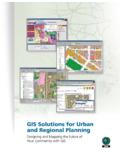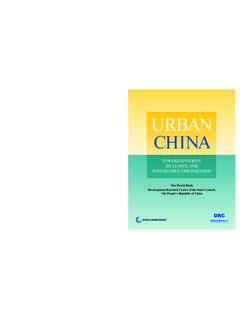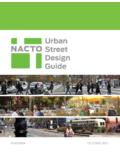Transcription of Healthy urban planning in practice: experience of European ...
1 Healthy urban planning in practice: experience of European citiesReport ofthe WHO City Action Group on Healthy urban PlanningEdited by:Hugh Barton, Claire Mitcham and Catherine urban planning IN PRACTICEA bstractHealthy urban planning means planning for people. Healthy urban planning a WHO guide to planning for people (SponPress, 2000) introduced the concept and principles of Healthy urban planning . This book describes the efforts of agroup of cities in the WHO European Healthy Cities Network to introduce health in their urban planning city case studies covering a wide range of approaches are presented and analysed. Some are at an early stage inlinking planning and health, whereas others have many years of experience on which to draw. Some focus on specificpolicy areas or projects, whereas others focus on the process of making plans. The analysis draws not only on thewritten material from each city but also on in-depth interviews with key protagonists and seminar discussions withinthe wider group of cities that participated in this work.
2 The book summarizes the conclusions and lessons learned andmakes recommendations for taking Healthy urban planning practices forward on a larger HEALTHCITY PLANNINGHEALTH PROMOTIONHEALTH POLICYEUROPEISBN 92 890 1088 6 Address requests about publications of the WHO Regional Office to: by (for copies of (for permission to reproduce (for permission to translate them) by postPublicationsWHO Regional Office for EuropeScherfigsvej 8DK-2100 Copenhagen , Denmark World Health Organization 2003 All rights reserved. The Regional Office for Europe of the World Health Organization welcomes requests for permissionto reproduce or translate its publications, in part or in designations employed and the presentation of the material in this publication do not imply the expression ofany opinion whatsoever on the part of the World Health Organization concerning the legal status of any country,territory, city or area or of its authorities, or concerning the delimitation of its frontiers or boundaries.))
3 Where thedesignation country or area appears in the headings of tables, it covers countries, territories, cities, or areas. Dottedlines on maps represent approximate border lines for which there may not yet be full mention of specific companies or of certain manufacturers products does not imply that they are endorsed orrecommended by the World Health Organization in preference to others of a similar nature that are not and omissions excepted, the names of proprietary products are distinguished by initial capital World Health Organization does not warrant that the information contained in this publication is completeand correct and shall not be liable for any damages incurred as a result of its use. The views expressed by authors oreditors do not necessarily represent the decisions or the stated policy of the World Health and started: the experience of Seixal, progressive, learning approach: the experience of Milan, integration: the experience of Gothenburg, spatial planning : the experience of Sandnes, open the barriers: the experience of Belfast, United as the goal of planning : the experience of Horsens, and principles and urban planning IN PRACTICEE ditorsHugh BartonExecutive Director, WHO Collaborating Centre for HealthyCities and urban Governance, University of the West ofEngland, Faculty of the Built Environment, Bristol, UnitedKingdomClaire MitchamUrban planner, postgraduate student, University of theWest of England, Bristol, United Kingdom.
4 Focal point forurban planning at the WHO Centre for urban Health(until 2002)Catherine TsourouArchitect and urban planner, Padua, ItalyCover design: Antonella Bruzzese, Milan, ItalyLayout and typesetting:Christensen Grafisk ApS, Copenhagen, DenmarkForewordThis publication is based on the experiences andwork of a group of member cities of the WHO Eu-ropean Healthy Cities Network, which has madeefforts to introduce Healthy urban planning intopractice. This is an exciting and challenging areaof work requiring the active engagement of urbanplanners and architects. After Healthy urban plan-ning a WHO guide to planning for people was pub-lished in 2000, WHO set up the WHO City ActionGroup on Healthy urban planning . Planners from12 diverse members of the WHO EuropeanHealthy Cities Network agreed to work togetherfor 3 years. The City of Milan supported the workof the Group. Participants were convinced of theimportance and the potential benefits of integrat-ing health into planning processes and practicesand therefore attempted to explain, promote andapply these ideas in their cities.
5 The Group be-came thus a forum for sharing and documents must be based on evi-dence. The knowledge acquired from testing newideas in practice can be an invaluable source oflearning and inspiration. Integrating health andquality of life considerations into planning prac-tices implies a cultural shift in how people under-stand and deal with space and human needs. TheGroup s work demonstrated that Healthy urbanplanning is worth developing and exploring fur-ther. The case studies are concrete examples ofhow health concerns can influence planning deci-sions. These are glimpses into the richness of thepractical implications of Healthy urban is giving high priority to Healthy urbanplanning. Healthy urban planning and health im-pact assessment are core developmental themesfor the fourth phase (2003 2007) of the WHO Eu-ropean Healthy Cities Network. Thus, many citieswill achieve the political legitimacy and the tech-nical support to work systematically and to inno-vate in urban planning and health.
6 The lessonslearned by the Group will be useful for the new-comers. Healthy urban planning should be in-creasingly recognized as a key domain for publichealth D. TsourosHead, Centre for urban HealthHealthy Cities and urban Governance programmeWHO Regional Office for urban planning IN PRACTICEA cknowledgementsThis work would not have been possible withoutthe generous support by the City of Milan and thecommitment of the member cities of the WHOCity Action Group on Healthy urban planning :Belfast (United Kingdom), Geneva (Switzerland),Gothenburg (Sweden), Horsens (Denmark), Milan(Italy), P cs (Hungary), Sandnes (Norway), Seixal(Portugal), Sheffield (United Kingdom), Turku(Finland), Vienna (Austria) and Zagreb (Croatia).Thanks are due to Emilio Cazzani (Head of theUrban planning Department of the City of Milan),Alessandro Balducci (Dean of the Politecnico deMilano Technical University) Eleuterio Rea (Headof the Social Services Sector for adults of the Cityof Milan) and Laura Donisetti (Coordinator of theHealthy City Project in Milan) for their extraordi-nary commitment to this work and most valuablecontributions to the work of the special word of thanks to Connie Petersen,who provided most efficient administrative sup-port to the Group, and Gill Weadon and JulieTriggle for excellent word-processing, often withvery tight deadlines.
7 Finally, many thanks toDavid Breuer, who considerably improved the lan-guage and style of the and contextHugh Barton1 Purpose and scopeThe WHO Regional Office for Europe launchedthe Healthy urban planning initiative in 1997 aspart of a move to integrate the agenda for healthwith that of sustainable development. Thehealthy cities movement had recognized from thestart that the quality, equity and efficiency of theurban environment profoundly influences the new initiative went further than that, see-ing human health and well-being as the centralpurpose of sustainable development. Health, itwas believed, should be a prime goal of urbanplanning, helping to provide a coherent and evi-dence-based foundation for WHO Healthy urban planning initiativehas involved collaboration between practitionersin the Healthy cities movement and academic ad-visers from England and Italy. The first phase ofthis collaboration resulted in Healthy urban plan-ning a WHO guide to planning for people in 2002.
8 2 The second phase involved the formation ofthe WHO City Action Group on Healthy UrbanPlanning. The members of the City Action Grouphave pushed forward with practical programmes,implementing the principles advocated in thebook. This new publication attests to their effortsand their book reviews the practical experience of arange of cities as they move towards health-inte-grated planning . The cities are self-selected mem-bers of the action group, but they do represent agood range of approaches. Some are at an earlystage in linking planning and health, whereas oth-ers have many years experience to draw on; someare concerned with specific policy areas or projects,whereas others focus on the process of plan-mak-ing. The people directly involved in each city wrotethe six case studies. They are structured on a com-mon pattern, telling the story of the developmentof their Healthy planning initiative and highlight-ing specific projects and programmes. Taken to-gether, the case studies offer a rich and diversesource of inspiration for others to 1 sets the scene for the city studies, sum-marizing the principles of Healthy urban planningand outlining the development of the WHO initia-tive on Healthy urban planning .
9 Chapter 8 analysesthe case studies. This draws not only on the writtenmaterial from each city but also on in-depth inter-views with key protagonists and seminar discus-sions within the wider City Action Group. Thisleads on to Chapter 9, the conclusions, recommen-dations and the next steps. The work reported hereis blazing a trail that all member cities will take upin the fourth phase of the WHO European HealthyCities Network: Healthy urban planning will be akey aspiration and WHO initiative on Healthy urbanplanningThe WHO initiative on Healthy urban planningwas based on a conviction that urban spatial andtransport planning significantly influence the de-1 Executive Director, WHO Collaborating Centre for Healthy Cities and urban Governance, University of the West of England,Faculty of the Built Environment, Bristol, United H, Tsourou C. Healthy urban planning a WHO guide to planning for people. London, E&FN Spon, AND urban planning IN PRACTICE terminants of health3 together with a recognitionthat attempts to change personal behaviour with-out changing basic social, economic and environ-mental conditions are likely to have little The third phase of the WHO EuropeanHealthy Cities Network (1998 2002) therefore em-phasized the need to promote health through ur-ban foundations for this initiative were laid inthe mid-1990s with the involvement of the WHOE uropean Healthy Cities Network in the EuropeanSustainable Cities & Towns Campaign.
10 The Cam-paign recognized the interrelationship betweenhealth and sustainable development6 and triggeredgrowing interest in the links between health andplanning policy. The historical connection betweenpublic health strategies and urban planning hadbeen severed in most cities, at some cost to people shealth, especially in terms of Healthy exercise androad safety. At the same time, in the aftermath ofthe United Nations Conference on Environmentand Development in Rio de Janeiro in 1992, localauthorities have been asked to produce LocalAgenda 21 strategies. urban planners became in-creasingly conscious of the need to plan explicitlyfor the quality of life and sustainable began regular work with urban planningpractitioners and academics in 1998. As a firststep, in 2000, Healthy urban planning a WHOguide to planning for people7 was published the re-sult of seminars and consultations across themovement. It advocates human health and well-being as a key goal of town planning and provides12 key health objectives for planners.

















